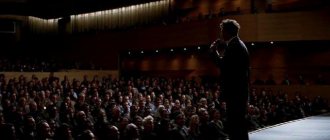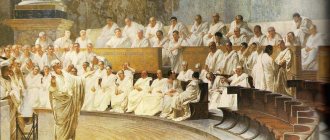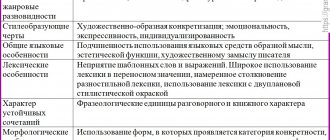Oratory in court
Exercise 9. Definition of judicial oratory
In the theory of public speech, oratory
is understood as a complex of knowledge and skills of a speaker in preparing and delivering a public speech: this is the ability to formulate a thesis and select material, the art of constructing a speech and public speaking in order to have a certain impact on listeners; this is the ability to prove and disprove, the ability to convince; this is the speech skill of N.N. Ivakin. Fundamentals of judicial eloquence (rhetoric for lawyers): A textbook for universities. - M.: Yurist, 2006. - P. 25.. Judicial oratory is one of the varieties of oratory.
Another name for judicial oratory
- judicial eloquence: the ability and ability to speak beautifully, convincingly with the aim of establishing the legal truth in the case, forming the internal conviction of judges. At the same time, judicial eloquence presupposes the evaluative and legal nature of speech, i.e. the judicial speech must be prepared and delivered in accordance with the requirements of the criminal procedure law. Criminal procedural law is a state-approved system of legal acts that contain rules governing legal proceedings.
Thus, judicial oratory
- this is
a complex of knowledge
and skills of a lawyer in preparing and delivering a public judicial speech in accordance with the requirements of the law; as the ability to construct objectively reasoned reasoning that forms scientific and legal beliefs; as the ability to influence people's legal consciousness.
Depending on the content of the statement, judicial speech is divided into three types: description; narration; reasoning
. The description speaks of simultaneous signs, the narration speaks of sequential actions, and the reasoning speaks of the causes of properties and phenomena.
In judicial speech, the description must be extremely complete, but without unnecessary linguistic means in order to avoid subjectivity. At the same time, the purpose of judicial oratory is to influence people’s legal consciousness. Legal consciousness
- this is, in a general sense, the subjective perception of legal phenomena by people.
The purpose of influencing legal consciousness is to form “scientific and legal beliefs”
. Those. Beliefs expressing an attitude towards law must be proven using objective evidence that is scientific. Most statements must contain facts that can be verified to be true. And, since value judgments, opinions, beliefs cannot be verified, therefore, they are not scientific and are not subject to legal protection.
Lexical language meanings are divided into demonstrative and characterizing. Demonstrative meanings (denotatives, nominatives) mean and name meaning or relation; characterizing meanings (modal, disignata) express the attitude towards this meaning or relation. The meaning “are or should be” is a characterizing meaning because it expresses the relation (“ought”) to the meaning “are” in the second part of the statement.
Accordingly, modality
There are two types - real (objective) and unreal (subjective). The forms of real moods represent an action that has already happened, is in progress, or is something that will happen in the future. In general, in all languages, these are forms of indicative, direct mood. The forms of indirect moods (imperative, conjunctive, optative, etc.) express meanings
In the story
Verbs in the past tense perfect form are often used, so it is necessary to remember that in a judicial narration many facts are assumed and are not fully proven and use other types of verbs (instead of “committed” - “Could have committed”).
Thus, the impact on judges is often manifested through infinitive sentences with modal words
that have the meaning of obligation: “one cannot disbelieve the given testimony” or “a conclusion must be drawn here.” Modal words are words with the help of which the speaker (writer) expresses his attitude towards what he is talking about: impossible, follows, must, etc.
In any reasoning
there are two parts. The first contains the thesis, i.e. a statement that needs to be proven.
Judicial speech includes all the types of speech considered: a description of the crime committed, the criminal, a story about the features of the committed act (highlighting the main facts and showing their relationship), reasoning about the guilt / innocence of the accused. But, since the main goal of judicial speech is to convince others of the correctness of their judgments, it is necessary that reasoning prevail in this speech (studying the essential properties of the crime, justifying their relationship). Argumentation
is the presentation of arguments with the aim of changing the position or beliefs of the other party (audience). An argument, or argument, is one or more related statements. An argument is meant to support a thesis.
In judicial oratory, various models of speech construction are used. When we ask what a word means, or when we answer this question, we use the “Name” semantic model
. This semantic model involves turning to the origin and meaning of the word denoting a phenomenon or concept that is included in the title of the topic of a judicial speech or is one of its ideas. Example: decoding of articles of the Criminal Code: “Murder, i.e. ....”
When we define a concept, we use such a semantic model of speech (top) as “Definition”.
To define the subject of speech means to name the general genus and its specific, specific difference from other objects of the same genus. This top allows you to make your speech clear and consistent. Example: “an act committed intentionally (that is, consciously, with an understanding of the harmful nature of the consequences caused by the act) is recognized as criminal...”.
The Definition and Name tops are similar in that both of these models clarify information about an object. But, if the top “Name” can be a subjective modality, then the top “Definition” must be objective and scientifically based.
So, to prepare a judicial speech, it is necessary to master the logic of reasoning and presentation, methods of persuasion, oratorical techniques, methods of preparing and delivering a convincing, influential speech. All this is taught by rhetoric, which is defined as the science of the conditions and forms of effective speech communication, of the diverse ways of persuading an audience through speech influence.
Exercise 15
An effective means of emotional influence in court is judicial eloquence.
.
The brevity of speech should be combined with its deep content, which is facilitated by emotionality and expressiveness. The material of the judicial speech itself evokes emotions. The expressiveness of a speaker’s speech depends on the independence of his thinking, on his interest in what he is talking about; from the ability to control your speech; from the conscious intention to speak expressively. Artistic, expressive speech arouses interest among judges and citizens present in the courtroom, maintains interest in the subject of the conversation, and is easy to remember
. Fine and expressive means of language help the judicial speaker to focus the attention of the court on certain details of the case.
The creation of expressiveness, as well as emotionality, is served by linguistic means, with the help of which the speaker expresses an emotional-volitional attitude towards the subject of speech and thereby influences the emotions of jurors and citizens listening to the case. The artistry of judicial speech
- this is the use of various figurative and expressive means when arguing statements. However, each figurative and expressive means is appropriate in judicial speech in the case when it helps to strengthen the sound of the argument, as well as to express an important idea, from the point of view of the speaker, and convey it to the court, the defendant or the citizens present in the courtroom.
The laws of formal logic teach that thought must be expressed clearly and precisely, reasoning must be consistent, consistent and justified. A system of inferences is needed through which a new position is derived. This logical operation of substantiating the truth of a judgment with the help of other true and related judgments is called evidence.
Logical proof operation
(i.e. justification for the truth of a position) includes three interrelated elements: thesis, arguments, demonstration.
The central point of each proof is the thesis
- a position whose truth must be proven. The entire content of speech is subordinated to its justification. However, the thesis must be reliable, otherwise it will not be possible to substantiate it. Demonstrative reasoning requires compliance with two rules in relation to the thesis: 1) logical certainty, clarity and accuracy of the thesis; absence of logical contradiction; 2) the immutability of the thesis, the prohibition of changing it in the process of this reasoning.
Proof is carried out by logical arguments, the use of convincing arguments, competent opinions aimed at causing conviction. Argument
- this is one or more interconnected statements (judgments) intended to confirm the truth of the thesis of N.N. Ivakin. Fundamentals of judicial eloquence (rhetoric for lawyers): A textbook for universities. - M.: Yurist, 2006. - P. 98.. In civil and criminal proceedings, arguments are understood as judicial evidence: this is any factual data about the circumstances that are important for the correct proceedings of a criminal, civil, arbitration, constitutional case.
Rhetoric recommends giving strong arguments first, then evidence of moderate strength, and at the end - one of the strongest arguments. Descending order of evidence should be avoided. The process of persuasion includes, in addition to the thesis and arguments, demonstration. Demonstration
is a form of logical connection between arguments and thesis. This is logical reasoning, a set of conclusions when deriving a thesis from arguments. To demonstrate means to show that a thesis is logically justified by arguments and is therefore true. You can complete the demonstration with the following constructions: From all that has been said...; that's why I believe (better - I affirm, I am convinced); Thus; From all that has been said, other similar conclusions can be drawn.
The thesis can be substantiated by direct or indirect evidence. Direct proof is carried out directly with the help of arguments, without involving any assumptions that contradict the thesis: a direct reference is given to arguments, facts confirming something, a reference to a generally accepted norm. In the speech of a judicial speaker, direct evidence is used when the role of arguments is played by the testimony of witnesses, written documents, and physical evidence. Information evidence (witness testimony, written documents) must be verified and its reliability must be proven.
Direct reasoning can take the form of deductive reasoning, induction, or analogy. Deductive method
consists in the fact that particular provisions (conclusions) are logically deduced from general provisions, rules, laws (premisses). A premise can be an axiom, a postulate, or simply a hypothesis that has the nature of general statements. This may be one or another well-known scientific position, the truth of which is beyond doubt, or legal norms and other evaluative standards. If the premises are true, then their consequences are true. Deduction is the main method of proof.
Inductive method
involves a presentation from particular facts to the establishment of general provisions; this is a logical transition from arguments to the thesis. It is especially important that the speaker provides impressive, concrete facts. The inductive method is often used when analyzing experimental data and when operating with statistical materials. The arguments here are, as a rule, factual data.
Indirect evidence
- a type of deductive proof in which the thesis is proven by refuting the antithesis, i.e.
proof by contradiction, since an antithesis is formulated and its inconsistency is proven. Thus, indirect evidence consists of the following stages: an antithesis
. Then, based on the law of excluded middle, a conclusion is drawn: since the thesis and antithesis exclude each other, the falsity of the antithesis means the truth of the thesis. The art of argumentation also presupposes the ability to refute.
Thus, the art of a judicial speaker is manifested in the ability to clearly define the topic of the dispute (thesis, target setting), to construct a judicial speech in such a way as to attract the attention of judges and keep it throughout the entire speech, in the ability to fully and objectively analyze the circumstances of the case, indicate the reasons for the crime or civil conflict, give a deep psychological analysis of the personality of the defendant and the victim, build a system of refutations and evidence, draw the right legal conclusions and convince the judges and the audience of this. To achieve this goal, the speaker must possess logical methods of proving theses and the ability to use artistic means of speech, allowing him to make the evidence more figurative, emotionally charged and expressive, thereby increasing the impact of his logic on the judges.
Exercise 17
The main goal of judicial rhetoric is to justify or refute the theses of evidence. This process (judicial debate) should be built in stages:
1. Clarify a controversial idea, clarify the thesis
. To do this, it is enough to clarify three questions regarding this thesis:
— are all the words and expressions of the thesis completely and clearly understandable to the audience? Here you need to use the “Name”, “Definition”, “Properties” and “Example” tops;
- whether we are talking about just one object, or about all objects of a given class without exception, or not about all, but some (most, many, almost all, several, etc.). Here it is necessary to use the tops “Genus and Species”, “Whole and Parts”. Clarification of this point is called clarification of the judgment (and therefore the thesis) by “quantity”.
Where the “quantity” of the thesis is not clear, as in the proposition “all robberies are carried out by this suspect with extreme cruelty,” the thesis is said to be indeterminate in quantity;
- you need to find out the modality of the thesis (undoubtedly true, reliable, undoubtedly false or probable to a greater or lesser extent). Depending on all this, various methods of proof have to be given.
2. Proof of the thesis - includes the following steps:
- establish the grounds (arguments) and the connection between them and the thesis. Here it is also necessary to use the tops “Genus and Species”, “Whole and Parts”;
- each important argument in the proof must be considered separately and also clarified as a thesis - by name, by quantity and by modality;
- identify errors in evidence. Errors are of three types: in the thesis, in the arguments (in the grounds), in the connection between the arguments and the thesis, in the “reasoning”.
Thus, methods of proof, as well as methods of refuting a thesis, depend on the degree of certainty (clarity) of the thesis and the arguments of its proof “by quantity”. To determine the thesis by quantity, it is necessary to determine the volumes of all concepts used in constructing the thesis. Each concept has two main logical characteristics - extensional (volume) and intensional (content). The scope of a concept is a class of objects isolated from the universe and generalized in a given concept. P. Materna. The concept of a concept // Logical Research. Issue 2. - M.: Nauka, 2003. - P. 82-89.
. Individual objects from a given class are called elements of the concept scope. The content of a concept is a sign with the help of which objects are isolated and generalized.
The thesis is determined by quantity using the logic of simple statements. A simple attributive, or categorical, proposition consists of a subject, a predicate and a connective; its logical scheme is S-P, where S is the subject of the judgment, P is the predicate of the judgment, “-” is the connective. The subject and predicate are called terms of judgment. Each of them plays a special cognitive role. The subject of judgment reflects what we judge, i.e. subject of judgment. It contains the original knowledge. The predicate reflects the attribute of the subject, what is said about the subject of the judgment; it contains new knowledge about him.
According to the quantitative (volume) indicator expressed by the quantifier, simple categorical judgments are divided into single, particular and general. A single judgment reflects a single subject of thought, i.e. the subject of this judgment is a single concept: “Only one person passed through the checkpoint at that moment.”
A particular judgment reflects a certain set of objects, but not all of them, which is emphasized by the quantifier: “Some S are P,” “Many students are excellent students,” “There are S that are P.” A more detailed examination of the quantifier of existence reveals that, in quantitative terms, private judgments are still very uncertain. Thus, the expression “Some of those present were armed” allows for several meanings: “Some, or maybe the majority, or maybe all...”, “Some, or perhaps one...”, “Some and only a few...”. Overcoming the quantitative uncertainty of private judgments requires good knowledge of the subject area that they reflect.
On a qualitative basis, i.e. According to the nature of the connective, simple categorical judgments are divided into affirmative and negative.
According to the combined qualitative and quantitative criteria, all simple categorical judgments are divided into six types: general affirmative, general negative, particular affirmative, particular negative, singular affirmative and singular negative. Usually, in logic, all the properties of general judgments are transferred to individual ones, because the subject of individual judgments, like the subject of general ones, completely exhausts its subject area, therefore individual judgments are not distinguished as a special type.
The remaining four types of simple categorical judgments have special letter designations in logic, convenient for formulaic notation: A - general affirmative, E - general negative, I - particular affirmative, O - particular negative.
A formallogical analysis of these judgments makes it possible to identify some of their structural patterns that do not depend on the content of the judgments. Based on the structure of general (both affirmative and negative) judgments (“All S are P”, “All S are not P”, or, which is the same thing, “No S is P”), it is possible not knowing the content, say that their subjects are taken in their entirety (for a negative case, they are completely excluded from consideration). In logic, a concept taken in its entirety or completely excluded from consideration is called distributed. Thus, the general, logical position for these judgments is formulated as follows: the subjects of general judgments are always distributed. It is clear that the subjects of private judgments will always be undistributed, since they are talking only about “some S”.
As for the predicates of negative judgments, since they are completely excluded from consideration - “is not P”, “are not P”, then they are always distributed. Predicates of affirmative judgments do not clearly demonstrate their volumetric characteristics. Taking into account the uniqueness of the affirmative copula, which can express both identity (when S is equal to P) and subordination, partial coincidence (when S is only a part of P and when P is only a part of S), we have to conclude: the predicates of affirmative judgments, as a rule, are undistributed (taken only in part of its volume). In those special cases when the predicate is subordinate to the subject, i.e. its volume is completely included in the volume of the subject, or when they are identical in volume, then the predicate of affirmative judgments can be distributed. For example. “All drug addicts are weak-willed people” or “Some students were intoxicated.”
Thus, the main feature of a thesis is its predicativeness. Predicativeness is a meaningful feature of a judgment.
Exercise 19
oratorical rhetoric judicial speech
Speech structure -
This is the construction of speech, determined by its content, character, purpose. Judicial speech is characterized by a three-part division: introduction, main part, conclusion.
Introductions
accusations and defenses differ in content and goals. The prosecutor, as a “public judge,” has a dominant position, since, regardless of whether the prosecutor supports the prosecution, considering the crime proven, or refuses it, considering the crime unproven, with his speech he helps the court to make a legal and reasonable verdict. Beginning a speech with a statement of the circumstances of the case introduces them to the context of what happened, arouses interest, and psychologically prepares them for the correct perception of the analysis of the circumstances of the case. It not only arouses an emotional attitude towards what is being reported, but also awakens the mind, forcing once again to remember all the details of the crime. In the introduction to the indictment, an assessment of the social danger of the crime is often given.
The opening part of a defense speech depends on the task facing the lawyer in a particular trial and on the speaker’s goal setting. A lawyer who is confident in the client’s innocence may begin his presentation by characterizing his personality. This will help draw the jurors’ attention to the moral qualities of the defendant, to the fact that in front of them is a law-abiding person.
main part
judicial speech is a collection of individual micro-themes related in meaning. These parts are as follows:
1. Statement of the factual circumstances of the case.
2. Analysis and evaluation of collected evidence.
3. Justification of the legal qualification of the crime.
4. Information about the identity of the defendant (plaintiff, defendant).
5. Analysis of the causes and conditions that contributed to the commission of the crime.
6. Opinion on the measure of punishment.
In this part, the prosecutor’s goal is to put forward a thesis in favor of the defendant’s guilt, and the lawyer’s goal is to refute the prosecutor’s theses and put forward antitheses.
An important compositional part of judicial speech is the conclusion
- the last part, the end of the speech. It should sum up everything that has been said. If at the beginning of the speech the speaker needs to attract the attention of the judges, then at the conclusion it is important to strengthen the meaning of what was said. The conclusion of the lawyer's speech should cast doubt on the prosecutor's theses. The conclusion of the prosecutor's speech should help the court not only correctly resolve issues related to the sentencing, but also have educational value.
When starting to develop an argumentative speech, the speaker should formulate the thesis as early and accurately as possible. Thesis
can be formulated in the introduction, completing it and at the same time opening the main part of the speech.
The thesis must remain unchanged throughout the entire proof. Arguments ( auxiliary theses
) must be true and sufficient to prove the thesis: their truth must be proven regardless of the thesis.
In the main part, the presentation of the material is carried out mainly through reasoning, refutation and proof (argumentative type of presentation). The argumentative type of presentation is characterized by logical forms of development, reflecting the sequence of thought: a thesis is put forward, a concept is defined, logical connections are established between concepts. Argumentative sequences can be correlated with such structural parts of judicial speech as “Analysis and evaluation of evidence”, “Justification of the legal qualification of the crime”, “Considerations about the measure of punishment”, since in these compositional parts the object of judgment is such signs and actions that need to be identified when comparing facts in a cause-and-effect relationship.
Exercise 25
Attention to a speech largely depends on how it begins, how the speaker is able to establish contact with the court, how he activates the attention of listeners, and how he psychologically prepares them for the perception of information. Speaker's tasks in the introduction
: attract the attention of listeners; tune the audience to a positive perception of speech; prepare the ground for developing a topic.
Basic Techniques
, used here: appeal, appeal to the interests of the audience, to famous events, to the speech of the previous speaker, to known sources of information or authorities, as well as questions to the audience. It is in the interests of the speaker to demonstrate his honesty, objectivity, and interest in general agreement. In the introduction to a persuasive speech, you can formulate its main thesis or (depending on the characteristics of the audience) say what issue will be addressed in the speech and what problems related to this issue you will focus on.
Whatever introduction the judicial speaker chooses, it is important to remember that: it should reflect the conflict on which the judicial speech is based; it must be connected with the main part and serve as a starting point for examining the circumstances of the case; should not be long; stylistically it should be in harmony with the main part.
Analysis of the introduction to the judicial speech
Andreevsky S. A. Judicial speeches of famous Russian lawyers. Collection. - M., State Publishing House of Legal Literature, 1957. - P. 119-120
Thematic division of the introduction
1. Assessing the social significance of the decision made in this trial
Gentlemen judges! Gentlemen of the jury! A truly famous process is waiting for you to have your say - this time probably your last. In this important and intricate process, we would not at all want to go into the darkness that is favorable for us in order to find a win in the case. No! We would like to offer you an honest guide to our experience, to put in your hands a clear lamp in which you, together with us, would go through all the jungles of investigative proceedings and emerge from it along the path of truth. It should not be forgotten that the Sarah Becker murder case remains historical in the legal annals; it will gain its fame as an important temptation for the judiciary to fall into error. The conviction of an innocent person, or the mere possibility of it, is already a social misfortune that should be studied and noted so that the errors that caused it are not repeated. Therefore, I hope you will be attentive to us.
2. Statement of problems of proving a crime
It should be noted that we are all now in incomparably better conditions than at the first hearing of the case. The Senate acted with great wisdom that it forced Mironovich alone to judge. The way the matter was presented the first time, it was never possible to resolve it correctly. Then the prosecutor put two mutually exclusive murderers in the dock - Mironovich and Semenova - and said: “Choose anyone! There will be some left for me." And although for the sake of form Mironovich was called the perpetrator of the murder, and Semyonova the conniver, everyone felt that there would be a desperate struggle between them and that there would be no end to the lies. The Senate cut through this unnatural interweaving of Mironovich and Semyonova, and in essence the Senate decree, if we look beyond the formalities, says to the persecuting authorities: “be more frank in your methods.”
3. Description of the protection strategy
And now it really is easier. Although Semenova and Bezak are cut off, the integrity of the picture is not broken. On the contrary, with the disappearance of these areas, the policy of separating defenses disappears for us, and we can treat them with a lighter heart, without fear of damaging them.
4. Call for comprehensive and careful selection of evidence
The second advantage of the current proceedings is our general enrichment in the methods of criticism......
In creating the first three highlighted semantic parts, the speaker used linguistic means of artistic style
speeches: “important and confusing”, “to give you a clear lamp”, “all the jungle of investigative proceedings”, “with great wisdom”, “prosecutor .... said: choose anyone! I’ll have some left,” “Semyonova and Bezak are cut off.” The purpose of using means of increasing the expressiveness of the text is to attract the attention of listeners, to emotionally tune them in one’s favor.
General idea
contained in the third part of the introduction, it consists in encouraging judges and juries to come to a new decision in the case, without particularly taking into account the testimony of Semenova and Bezak, i.e. without taking into account such an aggravating feature of the crime as complicity.
About the number of thesis
the speech is in the second of the highlighted semantic parts. The lawyer transformed the prosecutor’s private judgment: “Either Mironovich or Semenova could be the killers” into a single judgment: “Mironovich could be the murderer.” To do this, the lawyer used the “from the opposite” method, showing the absurdity of the prosecutor’s judgment.
Bibliography
1. Andreevsky S.A. Judicial speeches of famous Russian lawyers. Collection. - M., State Publishing House of Legal Literature, 1957.
2. Ivakina N.N. Fundamentals of judicial eloquence (rhetoric for lawyers): A textbook for universities. - M.: Yurist, 2006.
3. Materna P. The concept of a concept // Logical Research. Issue 2. - M.: Nauka, 2003. P. 82-89.
4. Popovskaya L.V., Lisochenko O.V. Rhetoric for lawyers: the basics of judicial eloquence: an educational and practical guide for university students. 2nd ed., revised. and additional - Rostov n/d: Phoenix, 2008.
Features of a lawyer’s speech culture
The legal profession requires not only high moral qualities and professional skills, but also broad general education.
A lawyer plays various communicative roles: he drafts bills, conducts business correspondence, he has to write protocols of interrogation and inspection of the crime scene, various resolutions, indictments, statements of claim, sentences and rulings, contracts and agreements.
A lawyer has to deal with people of a wide variety of professions and different levels of culture. And in each case it is necessary to find the right tone, words that argue and correctly express thoughts. The content of their explanations and testimony sometimes depends on how accurately these individuals understand the lawyer’s speech. Violation of language norms by a lawyer may cause a negative reaction from interlocutors. Unfortunately, there are cases when, due to an inaccurately asked question, the interrogated person asks to clarify or correct the incorrectly asked question. In addition, every lawyer also acts as a speaker, as a propagandist of legal knowledge, giving lectures; The prosecutor and lawyer make public speeches every day in trials, so a lawyer needs to have public speaking skills. The ability to speak publicly and mastery of language has long been considered a necessary professional quality of a lawyer. It is also necessary to talk about a lawyer’s speech culture because legal language is specific. It contains many terms that have a special legal meaning, for example: code, smuggling, alibi, motives for a crime, etc. Some colloquial words that are outdated and not typical for general use are used as terms. Most ambiguous words denote special legal concepts. In the language of law there are phrases that are not used outside the legal sphere of communication.
In an official business style, a large number of ready-made, standard expressions - clichés - are used. Here the problem of cliches and cliches in a lawyer’s speech arises: the appropriateness and necessity of cliches when drawing up documents and the inappropriateness of speech cliches that cause harm. A lawyer’s speech culture also presupposes knowledge of the norms of oral public speaking. Even Cicero, the famous Roman orator and theorist of eloquence, noted that “the truly eloquent is the one who expresses ordinary objects simply, great ones - sublimely, and average ones - with moderation.” The speeches of the prosecutor and lawyer in court reflect the same facts as in the procedural documents in this case, so the court speaker often uses constructions that are appropriate only in written official business speech. And public speech requires a rich vocabulary and artistic expressiveness! The term speaker denotes not only the person giving a speech, but also a person who masters the skill of public speaking and its methodology. Speech should be constructed in such a way that it attracts attention and best contributes to persuasion.








